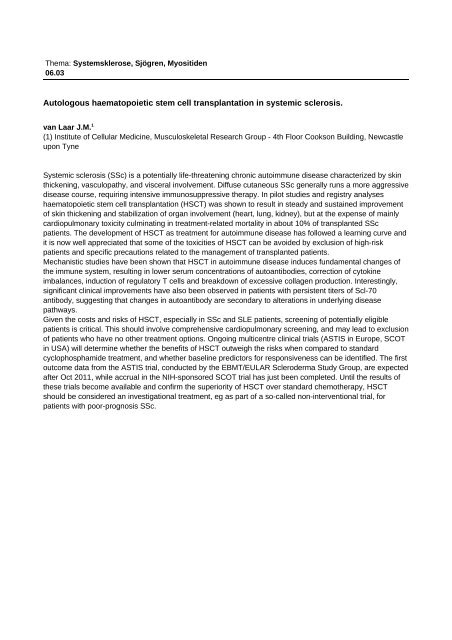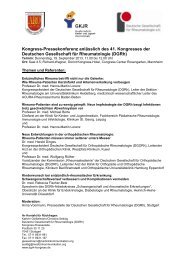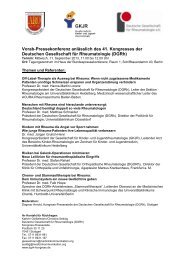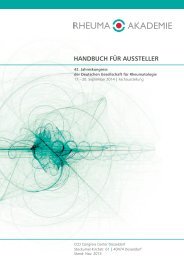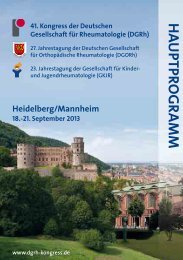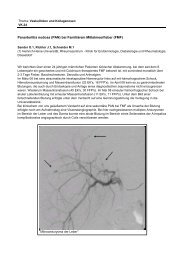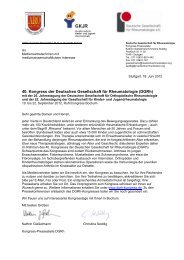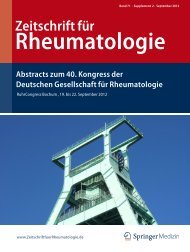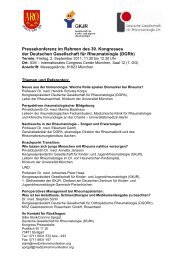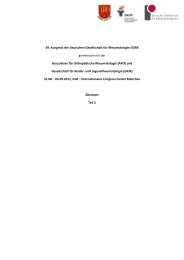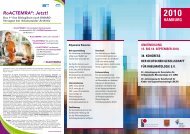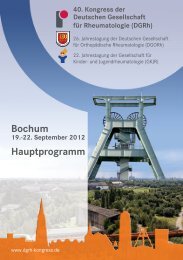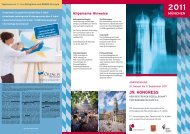Vorträge - Dgrh-Kongress
Vorträge - Dgrh-Kongress
Vorträge - Dgrh-Kongress
Sie wollen auch ein ePaper? Erhöhen Sie die Reichweite Ihrer Titel.
YUMPU macht aus Druck-PDFs automatisch weboptimierte ePaper, die Google liebt.
Thema: Systemsklerose, Sjögren, Myositiden<br />
06.03<br />
Autologous haematopoietic stem cell transplantation in systemic sclerosis.<br />
van Laar J.M. 1<br />
(1) Institute of Cellular Medicine, Musculoskeletal Research Group - 4th Floor Cookson Building, Newcastle<br />
upon Tyne<br />
Systemic sclerosis (SSc) is a potentially life-threatening chronic autoimmune disease characterized by skin<br />
thickening, vasculopathy, and visceral involvement. Diffuse cutaneous SSc generally runs a more aggressive<br />
disease course, requiring intensive immunosuppressive therapy. In pilot studies and registry analyses<br />
haematopoietic stem cell transplantation (HSCT) was shown to result in steady and sustained improvement<br />
of skin thickening and stabilization of organ involvement (heart, lung, kidney), but at the expense of mainly<br />
cardiopulmonary toxicity culminating in treatment-related mortality in about 10% of transplanted SSc<br />
patients. The development of HSCT as treatment for autoimmune disease has followed a learning curve and<br />
it is now well appreciated that some of the toxicities of HSCT can be avoided by exclusion of high-risk<br />
patients and specific precautions related to the management of transplanted patients.<br />
Mechanistic studies have been shown that HSCT in autoimmune disease induces fundamental changes of<br />
the immune system, resulting in lower serum concentrations of autoantibodies, correction of cytokine<br />
imbalances, induction of regulatory T cells and breakdown of excessive collagen production. Interestingly,<br />
significant clinical improvements have also been observed in patients with persistent titers of Scl-70<br />
antibody, suggesting that changes in autoantibody are secondary to alterations in underlying disease<br />
pathways.<br />
Given the costs and risks of HSCT, especially in SSc and SLE patients, screening of potentially eligible<br />
patients is critical. This should involve comprehensive cardiopulmonary screening, and may lead to exclusion<br />
of patients who have no other treatment options. Ongoing multicentre clinical trials (ASTIS in Europe, SCOT<br />
in USA) will determine whether the benefits of HSCT outweigh the risks when compared to standard<br />
cyclophosphamide treatment, and whether baseline predictors for responsiveness can be identified. The first<br />
outcome data from the ASTIS trial, conducted by the EBMT/EULAR Scleroderma Study Group, are expected<br />
after Oct 2011, while accrual in the NIH-sponsored SCOT trial has just been completed. Until the results of<br />
these trials become available and confirm the superiority of HSCT over standard chemotherapy, HSCT<br />
should be considered an investigational treatment, eg as part of a so-called non-interventional trial, for<br />
patients with poor-prognosis SSc.


